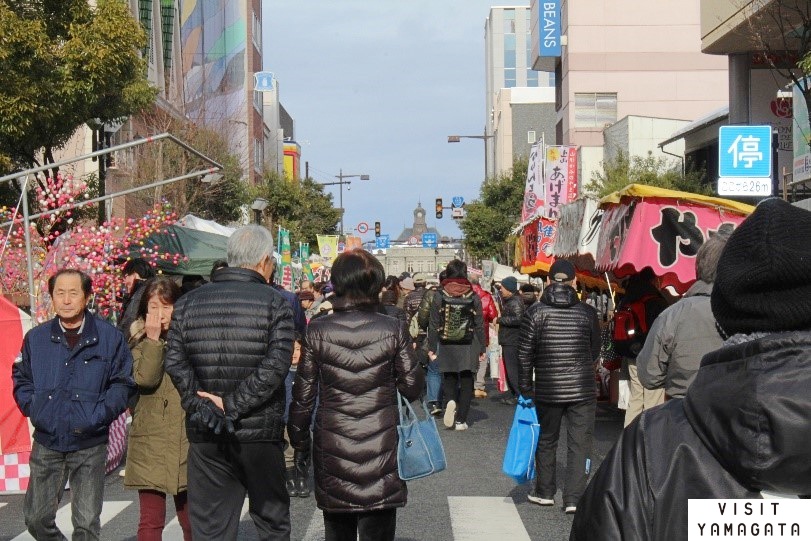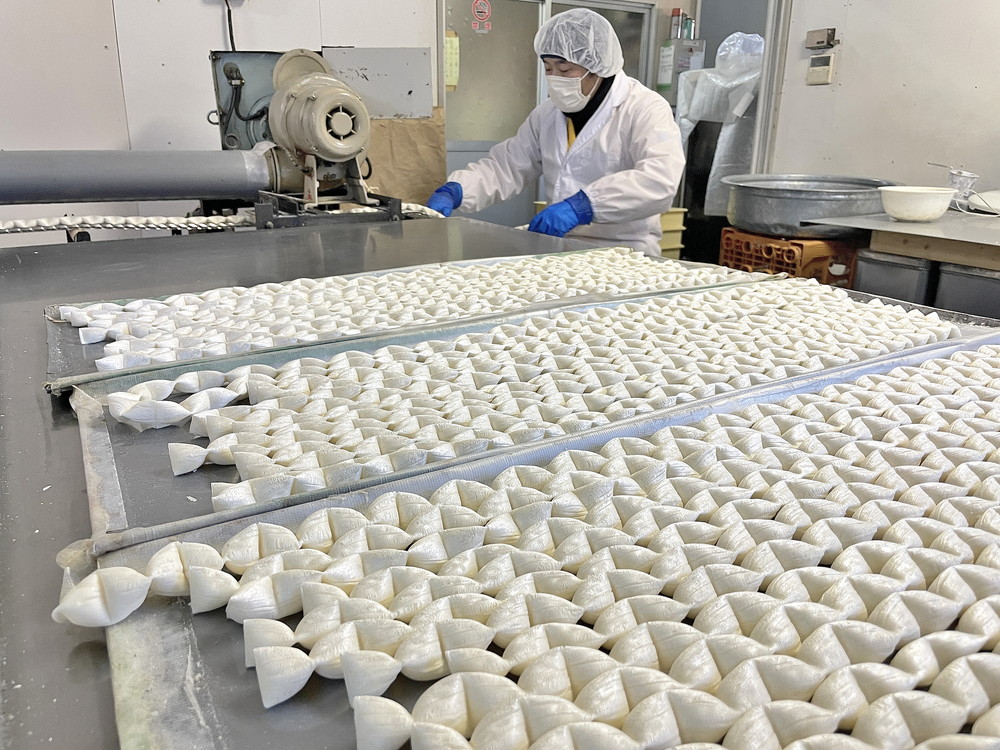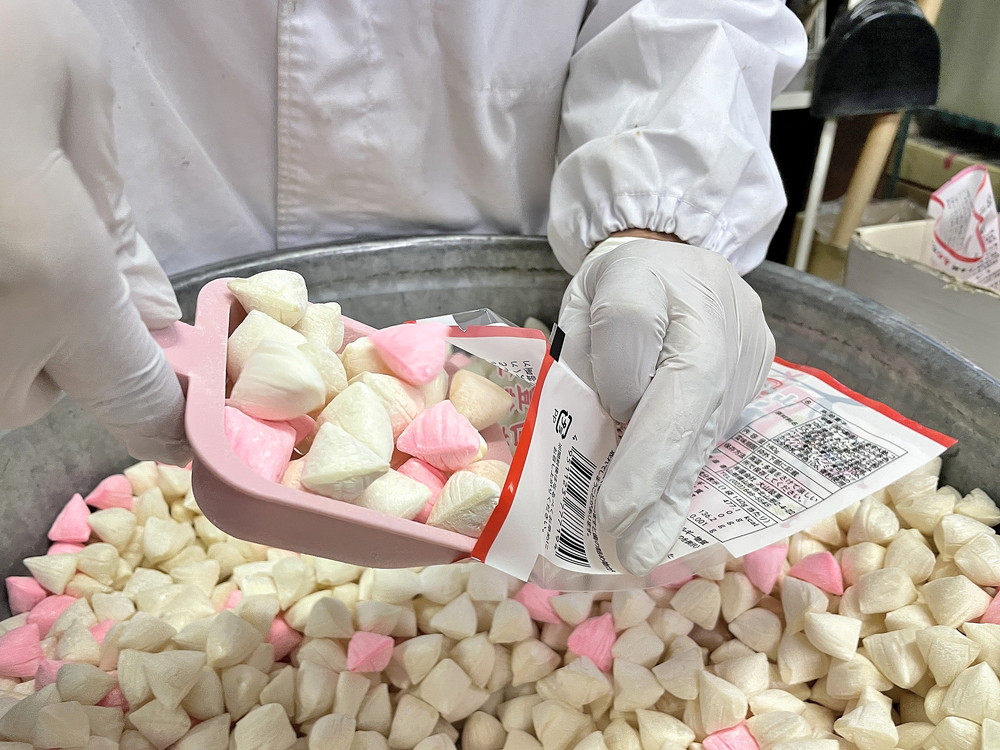Feature
- VISIT YAMAGATA
- Feature
- [Feature] Oyama Confectionery! Yamagata’s last candy store
[Feature] Oyama Confectionery! Yamagata’s last candy store
- Yamagata
- 2022.06.13
Food
Recommended Sweets

Oyama Confectionery is the only candy specialty store remaining in Yamagata prefecture.
In mid-December 2021, when I visited for this interview, the production of their hatsu ame, a lucky charm “first candy” for the New Year, reached its peak.
In this article, I would like to introduce the history of hatsu ame, how it was manufactured, and the other attractive products of Oyama Confectionery.
1. Oyama Confectionery
Oyama Confectionery Co., Ltd. has celebrated its 60th anniversary.
As the last candy specialty store that remains in Yamagata Prefecture, we have inherited the traditional taste and technique while performing most of the process by hand.

Oyama Confectionery is famous for its hatsu ame (first candy), but it also offers other products, such as candy for souvenirs, Chitose candies, and custom-made candies. Such products are available at the Yamagata Prefecture Tourist Product Center Gutto Yamagata. (^^)
This time, we interviewed Mr. Suzuki, the director and general manager of the general affairs department.
2. Hatsu ichi and hatsu ame
The hatsu ame candies are lined up in supermarkets in Yamagata Prefecture from late December.
They are also sold at hatsu ichi, the first market of the year in Yamagata City, which is traditionally held on January 10th.
Unfortunately, the first market of the year in 2021 was canceled, but in 2022, its location was moved to the Bunshokan (old prefectural office) with its scale reduced. At the same time, they will sell lucky charms such as dango wood, hatsu ame candies, and woodcraft.
The hatsu ame (first candy) and hatsu ichi (first market) are inseparable!
So, first of all, I would like to briefly introduce both.
① Hatsu ichi
Yamagata City’s hatsu ichi is the first market of the year. It is a 400 year-old tradition of Yamagata’s New Year, which began in the early Edo period from 1546 to 1614.
During the time of Lord Mogami Yoshiaki, Yamagata had regular markets held on set days of the month throught the city.
It is said that the first market of the year began with many stalls lined up from Tokamachi to Nanukamachi as a market deity festival on January 10th every year.

Vegetables such as turnip, which symbolizes commercial stocks (both “kabu” in Japanese), shiro-hige (“white beard”) chives which represent longevity, lucky charms such as hatsu ame candies and dangogi decorations, woodcraft such as cutting boards and mortars, vegetables, and grains. There are many stalls lined up, and it is crowded with more than 200,000 people from inside and outside Yamagata City.

2. Hatsu ame
Yamagata’s unique culture of hatsu ame, or first candy, is not found in other prefectures.

Originally called flag candy, heap candy, etc., it was made in the hope of a good harvest of safflower, a specialty of Yamagata.
Unlike the current shape of cut candy, it was sold on paper.
It is now sold as a lucky charm for disease-free breathing, prosperous business, and family safety.
The first candy of Oyama Confectionery that I visited this time has a wide variety of flavors!
Mainly macha green tea, sesame, red and white, anko, kinako, banana, strawberry milk, macha green tea milk that can only be tasted at the hatsu ichi, blueberry yogurt, dried plums, habanero, etc. (^^)
3. Tour of the factory
Oyama Confectionery manufactures various candies throughout the year.
When the room temperature is high, the ingredients melt and do not form a stick, so hatsu ame candies are a seasonal product that can only be made in winter when the humidity and temperature are low.
Mid-December, when I visited for this interview, was the heyday of making hatsu ame!
Most of the processes up to bagging was done by hand while adhering to the old manufacturing method.
① Boil down
The ingredients for the first candy are very simple!
Made with malt starch syrup and granulated sugar.

Delicate temperature control is important for boiling down the ingredients.
It seems that the texture will change with a slight difference in temperature, so all will be adjusted according to the humidity and temperature of the day at room temperature.
② Cool and make it moderately firm
The sugar solution boiled down at the perfect temperature is poured onto a large metal disk and cooled rapidly.

You can see that the texture has changed in a blink of an eye.

It has now hardened enough to be molded by hand.

You fold it while cooling it to make it moderately firm.

At the end, it was finished in such a bright and beautiful pot color.

It’s definitely delicious to eat as it is (^-^)
③ Pull candy
Next, we look at the process of pulling candy.
With this machine, they will knead the candy at high speed.

The candy changes from tortoiseshell to white.
By putting air bubbles inside, it seems that the texture will improve.

④ Molding
Next is the molding process.
First of all, they will make it into a rod shape with this special machine.

It may seem easy at first glance, but it requires delicate techniques that are very nerve-wracking.
Perfect temperature control is also essential when flowing, so they will make experience, intuition and touch-based judgments.

The stick-shaped candy comes out in a slender and long figure.

When it passes through a special mold, it becomes a familiar shape!

The candy that flows one after another is neatly arranged on the plate.

They let it cool for about a day and it’s done!

⑤ Packaging
The last process is packaging
A package of beautifully cut candy will be delivered to you.
Inside the factory, there was a pleasant sound of candy playing.

And here too, craftsmanship!
Instead of using a measuring instrument, they scoop the required amount by hand and add candies by looking at the package.

There was also a skill here (^-^)

Here is the first candy package completed in this way!

Born outside the prefecture, I tried hatsu ame for the first time, but the nostalgic, timeless and simple sweetness was fresh (^-^)
By the way, did you know that hatsu ame candies that are made through many processes and craftsmanship are actually a hit?
It seems that few people have come up so far, but if you find a heart-shaped candy in your package, you could receive assortment of Oyama Confectionery candies worth 3,000 yen!
When you pick up your hatsu ame, be sure to pay attention to its shape.
4. Other products
Oyama Confectionery is known for its hatsu ame candies, but it also produces many other attractive products.
You can discover them at the Yamagata Prefecture Tourist Product Center Gutto Yamagata, so be sure to pick them up.
① Candy using Yamagata’s special products
A candy made from cherry blossoms, which is also a symbol of Yamagata, the hana bekko ame containins safflower and chrysanthemum petals. The bara candy made from the edible rose “Rouge Royale” rose from Nojo Okuyama in Murayama City. There are also many other products such as candies that are full of the delicious charm of Yamagata.


By the way, the products I have just introduced are just a few of the many products manufactured by Oyama Confectionery.
② New products other than candy
Currently (December 2021), Murayama City’s special products are on display for a limited time at the Murayama area product information dissemination corner of the Murayama General Branch Office in Yamagata Prefecture.

Among them, three products of Oyama Confectionery were exhibited!
The bara syrup and bara salt are the latest products using roses as ingredients.

The bara syrup is an additive-free, non-colored syrup made only from sugar, water, and roses, with a “technique probably not used anywhere else.”
Oyama Confectionery also produces flexible products tailored to the client, without falling into the frame of a candy store.
I’m looking forward to seeing what kind of products will come out in the future (^-^)
③ Cotton candy

It looks cute and has a soft and gentle taste.
Small children who can’t eat candy yet and grandpas and grandmas can feel at ease when eating it.
5. Conclusion
While listening to Mr. Suzuki’s story, the part when he said:
“We make products that match the times with all our heart.
For that reason, I am honestly involved in manufacturing. “
was impressive.
Not only making candy in the factory, but also cotton candy and others according to the age of the people living there, such as “making cotton candy for a business trip to an elderly home” and “making custom-made candy for an English conversation class.”

Finally, Mr. Suzuki gave a message to everyone who is reading VISIT YAMAGATA.
“Our strength is that we can make custom orders.
We are waiting for you if you make a reservation for a business trip or candy making experience! “

![[Feature] Pino Collina Matsugaoka! Winery & Restaurant in Shonai](https://www.visityamagata.jp/wp/wp-content/uploads/2024/06/pinocollina.jpg)
![[Feature] Sahato Benihana! Enjoy the starry sky at the prefecture’s largest planetarium](https://www.visityamagata.jp/wp/wp-content/uploads/2024/07/sahato.jpg)
![[Summary] Safflower Festival 2024! Discover Yamagata’s prefectural flower](https://www.visityamagata.jp/wp/wp-content/uploads/2021/06/紅花①.jpg)
![[Feature] Miraini! Sakata Activity Hub](https://www.visityamagata.jp/wp/wp-content/uploads/2024/02/compile-image_1707742235039.png)
![[Feature] Yukotto! Refreshing time in hot springs](https://www.visityamagata.jp/wp/wp-content/uploads/2024/03/yukotto.jpg)